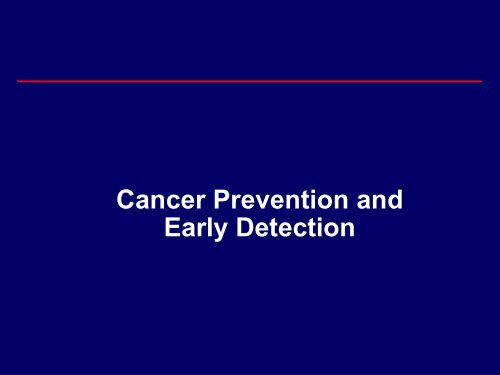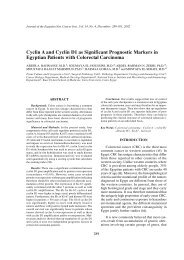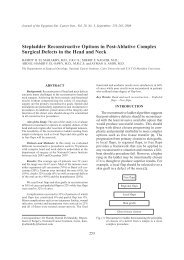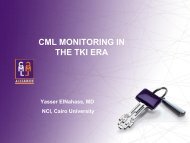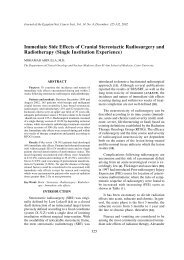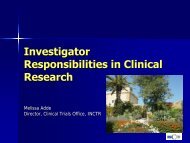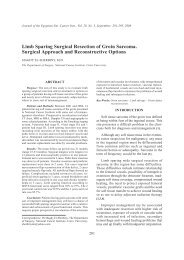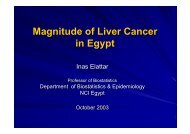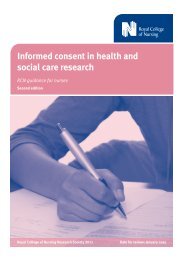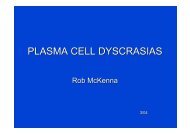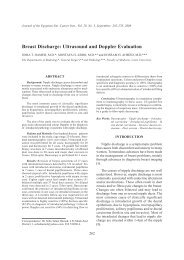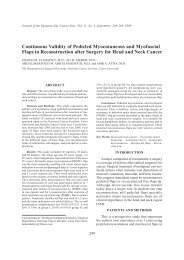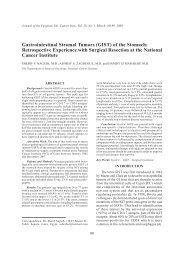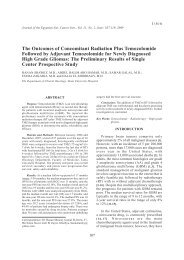Cancer Prevention And Early Detection - NCI
Cancer Prevention And Early Detection - NCI
Cancer Prevention And Early Detection - NCI
Create successful ePaper yourself
Turn your PDF publications into a flip-book with our unique Google optimized e-Paper software.
<strong>Cancer</strong> <strong>Prevention</strong> and<br />
<strong>Early</strong> <strong>Detection</strong>
<strong>Cancer</strong> <strong>Prevention</strong> Working Definition<br />
ASCO CAPC<br />
• A reduction in the risk of developing clinically<br />
evident cancer, whether first or second primary<br />
cancer, or of developing intraepithelial neoplasia<br />
(IEN), a frequent cancer precursor. Inherent in this<br />
definition is the early detection and treatment of<br />
IEN .
Earlier Definition<br />
• "primary" prevention (intervention for relatively<br />
healthy individuals with no invasive cancer and an<br />
average risk for developing cancer).<br />
• "secondary" prevention (intervention for patients<br />
determined by early detection to have<br />
asymptomatic, subclinical cancer).<br />
• "tertiary" prevention (symptom control,<br />
rehabilitation, or other issues in patients with<br />
clinical cancer .
• <strong>Cancer</strong> prevention science and practice are just beginning to gain<br />
public, academic, government and industry recognition as a major<br />
aspect of oncology .<br />
• <strong>Cancer</strong> prevention spans a wide range of disciplines, including<br />
population, behavioral, and social sciences; diagnostics; and clinical<br />
therapeutics (chemoprevention, risk reduction).<br />
• Diverse training and skills are required to fully address the spectrum of<br />
carcinogenesis and its control.<br />
• Risk-based management is the process of determining the best cancer<br />
prevention approaches for specific cancer risks
ASCO Strategic Plan 2004–2007: Goal<br />
<strong>Cancer</strong> <strong>Prevention</strong> and Control<br />
• Advocate for rapid, worldwide reduction and ultimate elimination of<br />
tobacco products and exposure to environmental tobacco smoke, in<br />
collaboration with other organizations and professional societies<br />
• Increase core knowledge about cancer risk and risk reduction through<br />
new education initiatives<br />
• Promote clinical, behavioral, and translational research, and education<br />
and training in cancer prevention and control<br />
• Work to eliminate healthcare disparities in cancer risk assessment and<br />
early detectionProvide prevention-oriented messages for individuals with<br />
a prior history of cancer and for the general public
<strong>Prevention</strong><br />
<strong>Cancer</strong> can be caused by a number of different factors and<br />
may develop over a number of years. Some risk factors can<br />
be controlled. Choosing the right health behaviors and<br />
preventing exposure to certain environmental risk factors can<br />
help prevent the development of cancer. For this reason, it is<br />
important to follow national trends data to monitor the<br />
reduction of these risk factors.
Behavioral Factors<br />
Scientists estimate that as many as 50 to 75 percent of cancer deaths in the United States are<br />
caused by human behaviors such as smoking, physical inactivity, and poor dietary choices.<br />
• Not using cigarettes or other tobacco products:<br />
• Not drinking too much alcohol<br />
• Eating five or more daily servings of fruits and vegetables<br />
• Eating a moderate-fat diet<br />
• Consuming a diet in which total calories eaten are balanced with calories<br />
expended by physical activity<br />
• Maintaining or reaching a healthy weight<br />
• Being physically active<br />
• Protecting skin from sunlight
Behavioral Factors<br />
• Smoking causes about 30 percent of all U.S. deaths from cancer. Avoiding<br />
tobacco use is the single most important step Americans can take to reduce the<br />
cancer burden in this country.<br />
• Obesity and physical inactivity cause about 25 to 30 percent of several of the<br />
major cancers in the U.S., including colon, breast, endometrial, kidney, and<br />
esophageal cancers. Obesity is estimated to cause 14 percent of cancer deaths<br />
in men and 20 percent of cancer deaths in women.<br />
• Additional important steps include maintaining a healthy weight, being physically<br />
active, eating a moderate-fat diet and enough fruits and vegetables, balancing<br />
calories with physical activity, avoiding too much alcohol, and protecting skin<br />
from sunlight.
Tobacco Control<br />
• Increasing efforts to discourage tobacco use, particularly among the young<br />
• Raising federal excise taxes by at least $2 per pack and encouraging states to consider<br />
tobacco taxes as a first resort in revenue enhancement<br />
• Ensuring that tobacco settlement funds be devoted only to health-related projects,<br />
including medical treatment, biomedical research, and tobacco prevention efforts<br />
• Comprehensively reforming third-party payment for tobacco cessation efforts<br />
• Additional restriction of secondhand smoke in any places where the public may<br />
congregate<br />
• Supporting necessary research into tobacco addiction, toxicities, and prevention strategies<br />
• Enhancing global tobacco control, including a halt of United States government promotion<br />
of tobacco products
Environmental Factors<br />
• Certain chemicals, biological agents, toxins, etc.<br />
are associated with cancer development.<br />
• Second hand tobacco smoke (also known as<br />
environmental tobacco smoke)<br />
• Pesticides<br />
• Dioxins
<strong>Early</strong> <strong>Detection</strong><br />
The use of screening tests to detect cancers early may<br />
allow patients to obtain more effective treatment with<br />
fewer side effects. Patients whose cancers are found early<br />
and treated in a timely manner are more likely to survive<br />
these cancers than are those whose cancers are not<br />
found until symptoms appear.
<strong>Early</strong> <strong>Detection</strong><br />
• Mammography (for breast cancer)<br />
• Pap test (for cervical cancer)<br />
• Fecal occult blood test (for colorectal cancer)<br />
• Colorectal endoscopy (sigmoidoscopy or colonoscopy<br />
for colorectal cancer)
Report Highlights<br />
2005 Update<br />
• Death rates for the four most common cancers (prostate, breast, lung, and colorectal), as well as for all<br />
cancers combined, continue to decline.<br />
• The rate of cancer incidence has been relatively stable since the mid 1990s.<br />
• Some prevention behaviors have shown improvement. Adult smoking is down dramatically since the<br />
1960s. Alcohol and fat consumption are headed down, while fruit and vegetable consumption is up only<br />
slightly since about 1990.<br />
• Youth smoking was on the rise during 1990s, but has shown declines since 1997.<br />
• The use of screening tests for breast and cervical cancers is high and remained stable between 2000<br />
and 2003. Screening for colorectal cancer remains low, despite its proven effectiveness..<br />
• People are doing slightly more to protect themselves from the sun .
Breast <strong>Cancer</strong>
Screening by Mammography<br />
Mammography use rose steadily in women ages 40 and older until<br />
2000 and has been stable since. The 2010 goal for all women was met<br />
by 2000, though disparities remain among racial/ethnic, geographic,<br />
and low-income groups. Statement of benefit<br />
Based on fair evidence, screening mammography in<br />
women aged 40 to 70 years decreases breast cancer<br />
mortality.<br />
The benefit is higher for older women, in part because<br />
their breast cancer risk is higher.
Screening by Clinical Breast<br />
Examination<br />
Statement of benefits<br />
Based on fair evidence, screening by<br />
clinical breast examination reduces<br />
breast cancer mortality.
THANKS


